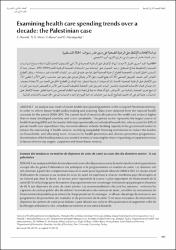| dc.contributor.author | Hamidi, Samer | |
| dc.contributor.author | Özgen Narcı, Hacer | |
| dc.contributor.author | Akıncı, Fevzi | |
| dc.contributor.author | Nacakgediği, Onur | |
| dc.date.accessioned | 10.07.201910:49:13 | |
| dc.date.accessioned | 2019-07-10T19:35:44Z | |
| dc.date.available | 10.07.201910:49:14 | |
| dc.date.available | 2019-07-10T19:35:44Z | |
| dc.date.issued | 2015 | en_US |
| dc.identifier.citation | Hamidi, S., Özgen Narcı, H., Akıncı, F. ve Nacakgedigi, O. (2015). Examining health care spending trends over a decade: The Palestinian case. Eastern Mediterranean Health Journal, 21(12), 861-870. https://dx.doi.org/10.26719/2015.21.12.861 | en_US |
| dc.identifier.issn | 1020-3397 | |
| dc.identifier.issn | 1687-1634 | |
| dc.identifier.uri | https://hdl.handle.net/20.500.12511/923 | |
| dc.identifier.uri | https://dx.doi.org/10.26719/2015.21.12.861 | |
| dc.description.abstract | An analysis was made of recent health care spending patterns in the occupied Palestinian territory, in order to inform future health policy-making and planning. Data were obtained from the national health accounts for the period 2000–2011. The current level of resource allocation to the health care sector is higher than in many developed countries and is not sustainable. The private sector represents the largest source of health financing (61%) and the burden falls disproportionally on individual households, who account for 63% of private health care expenditure. Key recommendations include: building capacity in the government sector to reduce the outsourcing of health services; modifying inequitable financing mechanisms to reduce the burden on households; and allocating more resources for health promotion and disease prevention programmes. Reorientation of the health system is also needed in terms of reducing the share of spending on inpatient services in favour of more day surgery, outpatient and home-based services. © 2015, World Health Organization. All Rights Reserved. | en_US |
| dc.description.abstract | َـة إعـام صنـاع السياسـات ُ ْغي اخلالصـة: لقـد أجـري حتليـل ألحـدث أنـاط اإلنفـاق عـى الرعايـة الصحيـة يف األرايض الفلسـطينية املحتلـة ب الصحيــة والتخطيــط هلــا يف املســتقبل. وتــم احلصــول عــى البيانــات مــن احلســابات الصحيــة الوطنيــة للفــرة 2000-2011 .حيــث وجــد أن املسـتوى احلـايل للمـوارد املخصصـة لقطـاع الرعايـة الصحيـة أعـى ممـا هـو عليـه يف كثـر مـن البلـدان املتقدمـة وغـر مسـتدامة. ويمثـل القطـاع اخلـاص أكـر مصـدر للتمويـل الصحـي )61 ،)%ويقـع العـبء عـى األرس بشـكل فـردي عـى نحـو غـر متناسـب، والتـي )األرس( تغطـي 63 % مـن اإلنفـاق عـى الرعايـة الصحيـة اخلاصـة. إن التوصيـات الرئيسـية تشـمل: بنـاء كـوادر يف القطـاع احلكومـي للحـد مـن االسـتعانة بمصـادر خارجيــة يف جمــال اخلدمــات الصحيــة، وتعديــل آليــات التمويــل غــر املنصفــة لتخفيــف العــبء عــن األرس، وختصيــص املزيــد مــن املــوارد لربامـج تعزيـز الصحـة والوقايـة مـن األمـراض. كـا أن هنـاك حاجـة إىل إعـادة توجيـه النظـام الصحـي مـن ناحيـة تقليـل حصـة اإلنفـاق عـى خدمـات رعايـة املـرىض الداخليـن لصالـح املزيـد مـن خدمـات جراحـة اليـوم الواحـد وخدمـات املـرىض اخلارجيـن واخلدمـات املنزليـة. | en_US |
| dc.description.abstract | RÉSUMÉ Une analyse a été faite des tendances récentes des dépenses en soins de santé dans le territoire palestinien occupé afin de guider l'élaboration des politiques et la programmation en matière de santé. Les données ont été obtenues à partir des comptes nationaux de la santé pour la période allant de 2000 à 2011. Le niveau actuel d’allocation de ressources au secteur de soins de santé est supérieur à celui de nombreux pays développés et ne s'inscrit pas dans la durée. Le secteur privé représente la source la plus importante de financement de la santé (61 %) et la charge pèse de manière disproportionnée sur les ménages individuels qui participent à hauteur de 63 % aux dépenses de soins de santé privées. Les recommandations clés sont les suivantes : renforcer les capacités du secteur public afin de réduire l’externalisation des services de santé ; modifier les mécanismes de financement inéquitables pour réduire la charge pesant sur les ménages ; et allouer davantage de ressources aux programmes de prévention des maladies et de promotion de la santé. Il est aussi nécessaire de réorienter les dépenses du système de santé pour réduire la part allouée aux services d'hospitalisation et augmenter celle de la chirurgie ambulatoire, des consultations externes et des soins à domicile. | en_US |
| dc.language.iso | eng | en_US |
| dc.publisher | World Health Organization | en_US |
| dc.rights | info:eu-repo/semantics/openAccess | en_US |
| dc.subject | Examining | en_US |
| dc.subject | Health | en_US |
| dc.subject | Palestinian | en_US |
| dc.title | Examining health care spending trends over a decade: The Palestinian case | en_US |
| dc.title.alternative | دراسة اجتاهات اإلنفاق عىل الرعاية الصحية عىل مدى عرش سنوات: احلالة الفلسطينية | en_US |
| dc.title.alternative | Examen des tendances en matière de dépenses de soins de santé au cours des dix dernières années : Le cas palestinien | en_US |
| dc.type | article | en_US |
| dc.relation.ispartof | Eastern Mediterranean Health Journal | en_US |
| dc.department | İstanbul Medipol Üniversitesi, Sağlık Bilimleri Fakültesi, Sağlık Yönetimi Bölümü | en_US |
| dc.identifier.volume | 21 | en_US |
| dc.identifier.issue | 12 | en_US |
| dc.identifier.startpage | 861 | en_US |
| dc.identifier.endpage | 870 | en_US |
| dc.relation.publicationcategory | Makale - Uluslararası Hakemli Dergi - Kurum Öğretim Elemanı | en_US |
| dc.identifier.doi | 10.26719/2015.21.12.861 | en_US |
| dc.identifier.wosquality | Q4 | en_US |
| dc.identifier.scopusquality | Q3 | en_US |


















